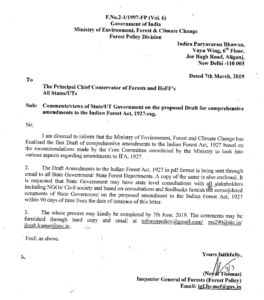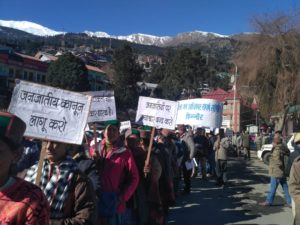Written by Arpitha Kodiveri
“The Forest Department is not ready to share its power; it sees itself as a landlord of these forest areas. The forest rights act challenges this and they are not willing to change the way they function. This is at the heart of the conflict”, said a forest-dweller in Sundergarh, Odisha when asked why the implementation of the Forest Rights Act (FRA),2006 has been so poor.*
India’s forests are a space regulated by conflicting laws. The legal regime that governed forests until 2006 had not acknowledged the rights of forest-dwelling communities who lived in and depended on forests for their sustenance. However, with the passing of the FRA, there was a decisive shift towards the recognition of these rights.

The FRA was implemented alongside forest laws that continued to assert state control of forest areas. The Indian Forest Act (IFA), 1927 is one of them. This Act emerged from the colonial notion of conservation, which gave immense power to the Forest Department to manage forests while excluding forest-dwelling communities.
While the FRA brought with it a progressive intention to democratize forest governance by recognizing the rights of forest-dwelling communities to conserve and use forest areas, this was not fully realized. In many ways, the implementation of the FRA occurred in the shadow of the IFA, and the recently proposed amendments to the latter further deepen this conflict.

Understanding the Two Acts
As mentioned earlier, the IFA gives the Forest Department control over the management of forest areas. The department has the power to draft a working plan for the forest area that regulates the boundaries of the forest and the exercise of forest rights. The department also enjoys a wide degree of discretionary powers, including the power to arrest without a warrant in the event that forest-dwellers are seen exercising their forest rights; the department is the creator and enforcer of forest rules.
This kind of system is an anomaly in the overarching body of Indian administrative authorities. The Forest Department can, on prima facie evidence, decide whether a forest offence has been committed and accordingly issue charges as well. For instance, there have been instances where members of forest-dwelling communities were arrested on the mere suspicion of carrying meat. This wide discretionary power has made forest areas hostile and restricted local communities from exercising their rights.
The recent National Crime Records Bureau report on crimes in India states that 78% of environment-related offences were committed under the IFA. A total of 3702 cases have been recorded, which showcases the gravity of the criminalisation of forest rights.
The FRA, on the other hand, recognizes the rights of forest-dwelling communities and individuals to conserve forest areas, which are termed as community forest rights and individual forest rights respectively. A report published by the Community Forest Rights- Learning and Advocacy Group showed that only three per cent of the conservation potential of community forest rights was realized in the span of ten years. The biggest hurdle has been in negotiating with the forest department to secede from governing areas where communities assert control.

Deepening this Conflict
The biggest challenge with the successful implementation of the FRA is that this Act has to be read in addition to and not in derogation of other laws. Thus, for the FRA to be appropriately implemented, it should be accompanied with amendments to the IFA in a manner that reduces the discretionary power of the forest department and challenges the provisions for the criminalization of forest rights.
Instead, the proposed amendments can potentially wreak more havoc. The amendments, in many ways, increase the discretionary powers of the forest department. For instance, it amplifies their policing powers in the exercise of forest offence provisions. While the forest department previously did enjoy powers of arrest without warrant and seizure of property from suspects, the proposed amendments recognize their right to use arms in regulating the use of forest resources. An addition to Section 66 of the Act states;
To provide indemnity to Forest-officer using arms etc., to prevent the forest offence. This indemnity shall be in addition to the immunity provided under section 197 of the Code of Criminal Procedure 1973 for certain categories of Public Servant.
It would not be wrong to say that this is similar to laws which have been known to promote police excesses like the Armed Forces (Special Powers) Act, 1976. The policing of forest-dwelling communities is already a matter of grave concern, even without these powers of absolute indemnity. In Kaziranga for instance, reporters from the BBC uncovered a shoot-at-sight policy that was in place to protect Rhinos, but on the mere suspicion of poaching, was also used against tribal communities living in the area.
This indemnity of a violent form of conservation is further exacerbated by provisions that reinstate the exclusion of forest-dwelling communities, where their rights can be acquired for the purpose of conserving forest areas. While Section 22 speaks to the need to record forest rights under the FRA, it also reasserts the control of the forest department in the governance of forest areas by allowing it to acquire forest rights if it does not fit within their model of conservation;
The State Government, after consultation with the Central Government, is satisfied that the exercise of any right whether individually or collectively is inconsistent with the conservation of the proposed reserved forest, may proceed to acquire such right and shall, subject to such rule, as the State Government may make in this behalf, commute such rights by payment to such persons.
The power of the state government to acquire forest land for conservation defeats the purpose of community forest rights recognized within the FRA. These amendments are a missed opportunity to reconcile a divide that exists between the forest department and the forest-dwelling communities.
A Bleak Future
The FRA is a law that aims to correct historical injustices and reshape forest governance in a way that puts forest-dwelling communities in the centre of the decision-making process. However, the proposed amendments to the IFA takes us many steps back and further restricts the rights of forest-dwelling communities. In this strange maze of conflicting laws, the question of justice to forest-dwelling communities is reduced, restricted or bypassed. It seems as though the spirit of democratizing forest governance is going to be sacrificed at the altar of increased state control.
*interview conducted during a field visit to Sundergarh in August 2018.
Featured image courtesy himdhara.org






